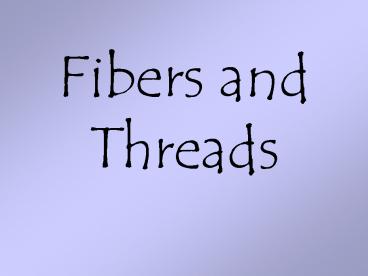Fibers and Threads PowerPoint PPT Presentation
1 / 19
Title: Fibers and Threads
1
Fibers and Threads
2
Cloth can yieldclass individual
characteristics. Matching fibers involves
comparingtype of fiber, color, type of
dye,production method.
3
Classification of Fiber
- Until 19th C. only natural fibers used to
- make clothing
- Mineral think earth glass, asbestos
- Animal silk, wool, fur
- Vegetable (plant) cotton, linen, hemp
- Synthetic rayon, nylon, acetate
- Currently 50 all fibers are synthetic
4
Natural Fibers
Many different natural fibers that come from
plants and animals are used in the production of
fabric.
Cotton fibers are the plant fibers most commonly
used in textile materials
The animal fiber most frequently used in the
production of textile materials is wool, and the
most common wool fibers originate from sheep.
http//www.fireflydiapers.com/articles/diaperartic
le_naturalfibersabsorb.htm
5
Synthetic Fibers
More than half of all fibers used in the
production of textile materials are synthetic or
man-made. Nylon, rayon, and polyester are all
examples of synthetic fibers.
Cross-section of a man-made fiber
6
- Synthetic Fibers
- Petroleum is the basis for these fibers, and
they have very different characteristics from
other fibers. - Monomers are joined together to form polymers.
The fibers produced are spun together into yarns.
- They have no internal structures, and under
magnification they show regular diameters.
7
Comparison of Natural and Synthetic Fibers
- Visual Diagnostics of Some Common Textile Fibers
- under Magnification
8
(No Transcript)
9
- Fibers can be twisted (spun) into
- any length, thick or thin, loose, or tight.
- A blend can be made to meet different needs such
as resistance to wrinkling. - Fibers can be woven into fabrics.
- Threads are arranged side by side (the warp).
- More threads (the weft) then are woven back and
forth crosswise in one of a number of different
patterns through the warp.
10
- Weave Patterns
11
What are some tests that will help to identify a
fiber?
12
Burn Test
- Burning a fiber can give you hints to the type
of fabric based on what you see - Characteristic odors
- Residues
- Beading
- Smoke or smolder?
- Flame or no flame?
13
Solvent/Solubility TestCan the fiber dissolve
in certain solvents?
- Often the following solvents are used to help ID
a fiber - HCl
- NaOH
- Bleach
- Acetone
- Dry-Cleaning Solvent
14
Stain Test(They show these types of tests in
laundry commercials all the time.)
- Will blood stain the cloth?
- Will blood bead off?
- Is this lipstick?
15
Microscopic Tests
- What can you see using the microscope?
- Weave
- Braids
- Folds Twists
- Translucency
- Fraying
- Was it cut or ripped?
16
Collection Methods
- The two most common ways to collect fiber
evidence are - 1. The Tape Method (you probably have done
this before when you have held a critter and they
have left half of their white fur on your black
shirt.) - 2. Sweeping/Vacuuming Method work well but
collects LOTS of other debris.
17
So Where else besides clothing do you look for
fibers?
- Rugs
- Drapes
- Couches
- Pillows
- Cars
18
You can really learn a lot of stuff from fiber
and other trace material.
19
Stuff like
- Rope characteristics
- of strands, twist direction, weave pattern,
color, diameter, weight - Soil, rocks, debris
- give possible location
- Building materials
- Wood plant material
- Skin cells on ropes
- (kidnapping, murder, suicide?)
- Fibers on duct tape.
- (kidnappers tool of choice)

